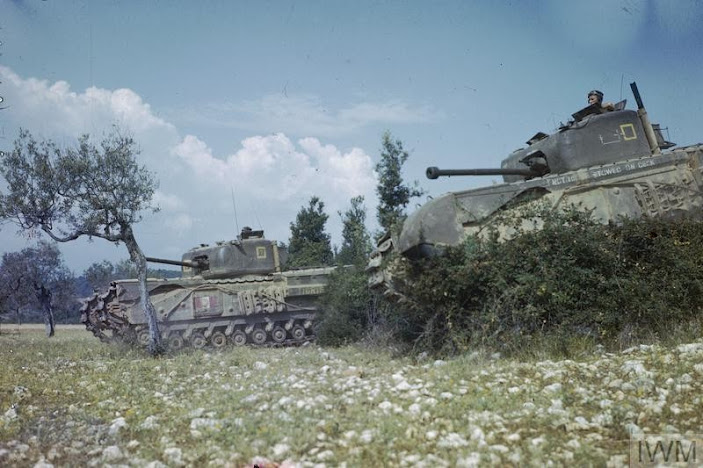Montgomery continues his attacks in Mareth line. A frontal attack failed to dislodge the Axis forces Montgomeryordered the 4th Indian Division on a "short left hook"
flank attack toward Ksar el Hallouf and Ben Zelten.
image from liberationtrilogy.com (2018)
|
This revised plan did not get off to a good start when X Corps HQ and 1st Armoured Division became snarled up with the 4th Indian in Medenine town. The 4th Indian had to hold back, and could not get moving until daylight on the 24th, so they were unable to mount their attack on the Hallouf Pass until that evening. Special detachments of the 164th Leichte division defend the defiles leading north of the Hallouf and Beni Kredache. The German defence in this sector was centre on the towm of Matmata. However, the 5th brigade led by the 4/6th Rajatput Battalion had cleared the pass by nightfall of the 25th, pushing the German 164th Light Division northwards.
The 7th Armoured Division were then ordered to follow up the 4th Indian Division and strike north in pursuit of the 164th Division through the Merbah El Ossif Pass and on towards Toujane. This feat of arms would win the 4th Indian Division a reputation as mountain warfare specialist through out the Tunisian and Italian campaign.
Indian divisions where organised along British lines with small variations in equipment so could be easily substituted for any other British or Commonwealth units.
The country towards Mareth is undulating. Sandy ridges and bush-covered wadis. Very green in places. The scrub is full of flowers, yellow and blue and white, in great numbers. In the hills deep defiles provide passable tracks through harsh and rocky hills. The area around Hallouf had been considered unpassable by motor traffic when the French built the Mareth line in the 1930's however by 1943 the LRDG reconnaissance considered it passable for modern motor vehicles and had demonstrated this in a series of patrols.
Eighth Army Forces
⦁ 4/6th Rajaput Infantry
⦁ 2 Platoons Commonwealth Infantry
⦁ 1st Platoon
⦁ HQ with 2" mortar
⦁ 3 Infantry sections
⦁ Vickers machine gun section with Bren Carrier
⦁ 3" mortar section
⦁ 2nd Platoon
⦁ HQ with 2" mortar
⦁ 3Infantry sections
⦁ 3" mortar section
⦁ 1 Infantry foot patrol
⦁ 1 Daimler AC from 11th Hussars
⦁ 1 Engineer section with mine sweepers and 1 demo charge in 15cwt truck
⦁ 1 timed barrage from 25 pounders of RHA
⦁ 1off table battery of 3" mortars
⦁
Special blocking force from 164th Leichte Division
⦁ 1 x Schutzen platoon
⦁ 1 HQ section
⦁ 3 Schutzen squad
⦁ Combat medic
⦁ Light Mortar team
⦁ HMG team with loader
⦁ 1 reserve schutzen section with medium truck
⦁ Defences
⦁ MG dugout
⦁ Mortar pit
⦁ 2x foxholes
⦁ AT gun dugout
⦁ Artillery Observation points
⦁ Off table artillery (2nd prority)
⦁ I battery off table 80mm mortars
Scenario
As in High Ground scenario in the Battlegroup rule book attacker divides force into 2 assault waves of equal size. Second wave enter table in Turn 4
Defender places all the defences before game begins may be placed anywhere in his half of table. They may choose which end is the defense zone D6 start with Ambush orders. Attacker deploy first wave within 10" of table edge and take first turn.
The area as hills are considered impasable terrain for vehicles patches of bushes on vally floor are difficult ground.
AAR
This one is part of 4th Indians role in the left hook of the Mareth line in Tunisia, 1943. It was a fun game hard work for both the Indian Infantry from British Infantry Division list in Battlegroup Torch and the 164th Leichte Divion on the defensive (using German Afrika Corps list from Battlegroup Torch). The Churchill was an ahistorical indulgence my opponent allowed me. As I created these Churchills for Tunisia games although Eigth Army had few of these vehicles and 4th Indian none for historical list see above. The high ground was impenetrable to vehicles this caused some problems. Enjoy.
Overview of the table with the infantry at there start lines
Indian infantry deploy into the Gully supported by the Churchill tank
Churchill advance - exciting for me!
The 164th Leichte Division blocking defenses
This MG34 HMG cause real problems (the puff of smoke represents Ambush fire)
Mortr fire pins the Indian infantry in the olive groves
Sniper takes up position on the roof of the farmhouse
British 25 pounders planned barrage crash in - but timed to early and far ahead of the infantry.
The Churchill continues to advance steadily as the PaK38 fails to spot.
The Germans defensive line
Indian sappers advance behind the Churchill
The second wave of Rajput Rgt. arrive with the battalion HQ
My new HQ model "O" group around the jeep bonnet.
Indian sappers close up
Pinned down the sappers are caught in a murderous crossfire
On the left the Germans well sighted MG bunker is a constant thorn
Recce foot patrol advances
,,,and catches a salvo of mortar fire
Aircraft chit - it failed to turn up
DAK hold this ruin with a medic as the front line
Looking down from the heights towards that ruin. The Indian's occupy the rocky heights.
The Churchill takes on the AT bunker head on.
Pinned down the DAK face a close assault by the Indian infantry
Cold steel - Bole Sohe Nihal , Sat Sri Akal!
The DAK fall back to the second line of defence
German medic heroically rescues men under mortar fire
This shallow gully was a killing zone for german mortars
The view from the B platoon HQ
Indian final BR two lucky draws kept them in the game.
DAK final BR they broke under constant pressure and a bayonet charge on there left flank.


































Comments
Post a Comment